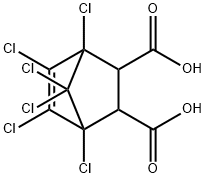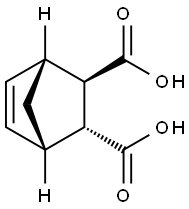Chlorendic acid
Synonym(s):1,2,3,4,7,7-Hexachlorobicyclo[2.2.1]hept-2-ene-5,6-dicarboxylic acid;Hexachloroendomethylenetetrahydrophthalic acid
- CAS NO.:115-28-6
- Empirical Formula: C9H4Cl6O4
- Molecular Weight: 388.84
- MDL number: MFCD00167589
- EINECS: 204-078-9
- SAFETY DATA SHEET (SDS)
- Update Date: 2025-07-04 15:22:14

What is Chlorendic acid?
Chemical properties
Chlorendic acid is a colorless crystalline solid.
The Uses of Chlorendic acid
Chlorendic acid is used as a flame retardant in polyurethane foams, resins, plasticizers, coatings, epoxy resins, and wool fabrics; in the manufacture of alkyl resins for special paints and inks; in the manufacture of polyester resins with special applications in electrical systems,paneling, engineering plastics, and paint; and in the manufacture of corrosion-resistant tanks, piping, and scrubbers. Chlorendic acid is also used as an extreme-pressure lubricant (NTP 1987, IARC 1990, IPCS 1996, HSDB 2009).
The Uses of Chlorendic acid
Hexachlorobicyclo[2.?2.1]?hept-?5-?ene-?2,?3-?dicarboxylic Acid is a novel flame retardant (NFR) which has also been observed as a toxic and environmental pollutant. Chlorinated Reactive Flame Retardant IntermediateEnvironmental toxin on US EPA Toxic Release Inventory list (TRI) list.
Definition
ChEBI: A bridged organochlorine compound resulting from the Diels-Alder reaction of hexachlorocyclopentadiene with maleic anhydride followed by hydrolysis of the resulting anhydride. A chemical intermediate used in the preparation of fire-retardant polyester resi s and plasticisers.
General Description
Fine white free-flowing crystals or white powder. Odorless.
Air & Water Reactions
Insoluble in water.
Reactivity Profile
Chlorendic acid readily forms salts with a variety of metals .
Fire Hazard
Chlorendic acid will burn when subject to direct flame, but is self-extinguishing when the flame is removed.
Safety Profile
Confirmed carcinogen with experimental carcinogenic data. A severe eye and mild skin irritant. When heated to decomposition it emits toxic fumes of Cl-.
Potential Exposure
Chlorendic acid is used to make other chemicals, polyester resins; in fiberglass reinforced resins; used for anticorrosion equipment and flame retardant applications of fabrics
Carcinogenicity
Chlorendic acid is reasonably anticipated to be a human carcinogenbased on sufficient evidence of carcinogenicity from studies in experimental animals.
Shipping
UN2928 Toxic solids, corrosive, organic, n.o.s., Hazard Class: 6.1; Labels: 6.1-Poisonous materials, 8-Corrosive material, Technical Name Required.
Incompatibilities
Compounds of the carboxyl group react with all bases, both inorganic and organic (i.e., amines) releasing substantial heat, water, and a salt that may be harmful. Incompatible with arsenic compounds (releases hydrogen cyanide gas), diazo compounds, dithiocarbamates, isocyanates, mercaptans, nitrides, sulfides (releasing heat, toxic, and possibly flammable gases), thiosulfates, and dithionites (releasing hydrogen sulfate and oxides of sulfur).
Waste Disposal
Dispose of contents and container to an approved waste disposal plant. All federal, state, and local environmental regulations must be observed.
Properties of Chlorendic acid
| Melting point: | 239-242 °C(lit.) |
| Boiling point: | 175°C (rough estimate) |
| Density | 1.7157 (estimate) |
| storage temp. | Amber Vial, -20°C Freezer |
| solubility | DMSO (Slightly), Methanol (Slightly) |
| form | Solid |
| pka | 1.26±0.70(Predicted) |
| color | White to Off-White |
| Stability: | Stable. Incompatible with strong oxidizing agents. |
| CAS DataBase Reference | 115-28-6(CAS DataBase Reference) |
| IARC | 2B (Vol. 48) 1990 |
| NIST Chemistry Reference | Bicyclo[2.2.1]-5-heptene-2,3-dicarboxylic acid, 1,4,5,6,7,7-hexachloro-(115-28-6) |
| EPA Substance Registry System | Chlorendic acid (115-28-6) |
Safety information for Chlorendic acid
| Signal word | Danger |
| Pictogram(s) |
 Corrosion Corrosives GHS05  Health Hazard GHS08 |
| GHS Hazard Statements |
H318:Serious eye damage/eye irritation H351:Carcinogenicity |
| Precautionary Statement Codes |
P201:Obtain special instructions before use. P280:Wear protective gloves/protective clothing/eye protection/face protection. P308+P313:IF exposed or concerned: Get medical advice/attention. |
Computed Descriptors for Chlorendic acid
New Products
4,4-Difluoropiperidine hydrochloride tert-butyl 9-methoxy-3-azaspiro[5.5]undecane-3-carboxylate Indole Methyl Resin N-Isopropylurea N,N-Dicyclohexylcarbodiimide(DCC) MELDRUMS ACID 5-METHYLISOXAZOLE-4-CARBOXYLIC ACID Magnessium Bis glycinate Zinc ascorbate 1-bromo-2-butyne 2-acetamidophenol 9(10H)-anthracenone Erythrosin B, 4-Piperidinopiperidine 2-((4-morpholinophenylamino) (methylthio) methylene) malononitrile 2,4-dihydroxybenzaldehyde 3-(4-morpholinophenylamino)-5-amino-1H-pyrazole-4-carbonitrile Methyl 2-methylquinoline-6-carboxylate 2,6-dichloro-4-nitropyridine 4-Bromo-2-chlorobenzonitrile 2-(benzylamino)acetic acid hydrochloride 4-(tert-Butoxycarbonylamino)but- 2-ynoic acid 3,4-dihydro-2H-benzo[b][1,4]dioxepine 1-Phenyl-1-cycloprppanecarboxylicacidRelated products of tetrahydrofuran





![3-([(2-CHLOROPROP-2-ENYL)OXY]CARBONYL)BICYCLO[2.2.1]HEPT-5-ENE-2-CARBOXYLIC ACID](https://img.chemicalbook.in/StructureFile/ChemBookStructure21/GIF/CB3786242.gif)
![Cis-exo-bicyclo[2.2.1]hept-5-ene-2,3-dicarboxylic acid](https://img.chemicalbook.in/CAS/GIF/21196-51-0.gif)

You may like
-
 Chlorendic Acid CAS 115-28-6View Details
Chlorendic Acid CAS 115-28-6View Details
115-28-6 -
 3-(4-amino-1-oxoisoindolin-2-yl)-1-methylpiperidine-2,6-dione 98%View Details
3-(4-amino-1-oxoisoindolin-2-yl)-1-methylpiperidine-2,6-dione 98%View Details -
 614-19-7 98%View Details
614-19-7 98%View Details
614-19-7 -
 3112-85-4 Methyl phenyl sulfone 98%View Details
3112-85-4 Methyl phenyl sulfone 98%View Details
3112-85-4 -
 20677-73-0 (2,2-diethoxyethyl)methylamine 98%View Details
20677-73-0 (2,2-diethoxyethyl)methylamine 98%View Details
20677-73-0 -
 3-(4-(hydroxyamino)-1-oxoisoindolin-2-yl)piperidine-2,6-dione 98%View Details
3-(4-(hydroxyamino)-1-oxoisoindolin-2-yl)piperidine-2,6-dione 98%View Details -
 57381-49-4 2-bromo-4-chlorobenzonitrile 98%View Details
57381-49-4 2-bromo-4-chlorobenzonitrile 98%View Details
57381-49-4 -
 4,6-dichloropyrimidine-5-carbaldehyde 98%View Details
4,6-dichloropyrimidine-5-carbaldehyde 98%View Details
5305-40-8
